Questões de Concurso Público METRÔ-SP 2010 para Analista - Arquitetura
Foram encontradas 60 questões
Posted on Friday March 27th, 2009 by Jebediah Reed
To give some sense of the pace of public works
construction in China, the city of Guangzhou is planning to open
83 miles of new subway lines by the end of next year.
Meanwhile, New York ? a city of about the same size ? has
been playing around with the 1.7-mile Second Avenue line for
decades now. China also builds subways rather cheaply ? $100
million per mile versus $ 2.4 billion per mile in the Big Apple.
Not surprisingly, projects there are more aggressive in all
respects: there are 60 tunnel boring machines operating in
Guangzhou, while only one is slated for the Second Avenue
project; workers put in five 12-hour shifts a week (and if they
don't like it, they can go pound glacial till); and seizing property
is a breeze.
An article in the Business section of today's NY Times
(Clash of Subways and Car Culture in Chinese Cities by Keith
Bradsher) [VERB] a smart look at the forces at play as China
goes on a transit infrastructure spending spree while it
simultaneously becomes evermore sprawling and car-centric.
Here's one interesting passage, [CONJUNCTION] the
story is worth reading in its entirety:
Western mass transit experts applaud China for investing
billions in systems that will put less stress on the environment
and on cities. But they warn that other Chinese policies, like
allowing real estate developers to build sprawling new suburbs,
undermine the benefits of the mass transit boom.
Mr. Chan Shao Zhang , a 67-year-old engineer in charge
of the works in Guangzhou, defended Guangzhou's combination
of cars and subways, saying that the city built a subway line to a new Toyota assembly plant to help employees and suppliers
reach it.
Subways have been most competitive in cities like New
York that have high prices for parking, and tolls for bridges and
tunnels, discouraging car use. Few Chinese cities have been
willing to follow suit, other than Shanghai, which charges a fee of
several thousand dollars for each license plate.
The cost and physical limitations of subways have
discouraged most cities from building new ones. For instance,
only Tokyo has a subway system that carries more people than
its buses. The buses are cheaper and able to serve far more
streets but move more slowly, pollute more and contribute to
traffic congestion.
China has reason to worry. It surpassed the United
States in total vehicle sales for the first time in January, although
the United States remained slightly ahead in car sales. But in
February, China overtook the United States in both, in part
because the global downturn has hurt auto sales much more in
the United States than in China.
There are many countervaling forces ..X.. China has
passed its own stimulus package and the government is eager
to put people to work, create economic activity, and build
modern infrastructure. The Guangzhou project is part of major
national transit buildout. But the nation's cities are also sprawling
beasts, and in that sense, more suited to cars than trains. Not
shockingly, many Chinese prefer the former.
(Adapted from http://www.infrastructurist.com/2009/03/27/-
building-a-subway-is-96-percent-cheaper-in-china/)
Posted on Friday March 27th, 2009 by Jebediah Reed
To give some sense of the pace of public works
construction in China, the city of Guangzhou is planning to open
83 miles of new subway lines by the end of next year.
Meanwhile, New York ? a city of about the same size ? has
been playing around with the 1.7-mile Second Avenue line for
decades now. China also builds subways rather cheaply ? $100
million per mile versus $ 2.4 billion per mile in the Big Apple.
Not surprisingly, projects there are more aggressive in all
respects: there are 60 tunnel boring machines operating in
Guangzhou, while only one is slated for the Second Avenue
project; workers put in five 12-hour shifts a week (and if they
don't like it, they can go pound glacial till); and seizing property
is a breeze.
An article in the Business section of today's NY Times
(Clash of Subways and Car Culture in Chinese Cities by Keith
Bradsher) [VERB] a smart look at the forces at play as China
goes on a transit infrastructure spending spree while it
simultaneously becomes evermore sprawling and car-centric.
Here's one interesting passage, [CONJUNCTION] the
story is worth reading in its entirety:
Western mass transit experts applaud China for investing
billions in systems that will put less stress on the environment
and on cities. But they warn that other Chinese policies, like
allowing real estate developers to build sprawling new suburbs,
undermine the benefits of the mass transit boom.
Mr. Chan Shao Zhang , a 67-year-old engineer in charge
of the works in Guangzhou, defended Guangzhou's combination
of cars and subways, saying that the city built a subway line to a new Toyota assembly plant to help employees and suppliers
reach it.
Subways have been most competitive in cities like New
York that have high prices for parking, and tolls for bridges and
tunnels, discouraging car use. Few Chinese cities have been
willing to follow suit, other than Shanghai, which charges a fee of
several thousand dollars for each license plate.
The cost and physical limitations of subways have
discouraged most cities from building new ones. For instance,
only Tokyo has a subway system that carries more people than
its buses. The buses are cheaper and able to serve far more
streets but move more slowly, pollute more and contribute to
traffic congestion.
China has reason to worry. It surpassed the United
States in total vehicle sales for the first time in January, although
the United States remained slightly ahead in car sales. But in
February, China overtook the United States in both, in part
because the global downturn has hurt auto sales much more in
the United States than in China.
There are many countervaling forces ..X.. China has
passed its own stimulus package and the government is eager
to put people to work, create economic activity, and build
modern infrastructure. The Guangzhou project is part of major
national transit buildout. But the nation's cities are also sprawling
beasts, and in that sense, more suited to cars than trains. Not
shockingly, many Chinese prefer the former.
(Adapted from http://www.infrastructurist.com/2009/03/27/-
building-a-subway-is-96-percent-cheaper-in-china/)
Posted on Friday March 27th, 2009 by Jebediah Reed
To give some sense of the pace of public works
construction in China, the city of Guangzhou is planning to open
83 miles of new subway lines by the end of next year.
Meanwhile, New York ? a city of about the same size ? has
been playing around with the 1.7-mile Second Avenue line for
decades now. China also builds subways rather cheaply ? $100
million per mile versus $ 2.4 billion per mile in the Big Apple.
Not surprisingly, projects there are more aggressive in all
respects: there are 60 tunnel boring machines operating in
Guangzhou, while only one is slated for the Second Avenue
project; workers put in five 12-hour shifts a week (and if they
don't like it, they can go pound glacial till); and seizing property
is a breeze.
An article in the Business section of today's NY Times
(Clash of Subways and Car Culture in Chinese Cities by Keith
Bradsher) [VERB] a smart look at the forces at play as China
goes on a transit infrastructure spending spree while it
simultaneously becomes evermore sprawling and car-centric.
Here's one interesting passage, [CONJUNCTION] the
story is worth reading in its entirety:
Western mass transit experts applaud China for investing
billions in systems that will put less stress on the environment
and on cities. But they warn that other Chinese policies, like
allowing real estate developers to build sprawling new suburbs,
undermine the benefits of the mass transit boom.
Mr. Chan Shao Zhang , a 67-year-old engineer in charge
of the works in Guangzhou, defended Guangzhou's combination
of cars and subways, saying that the city built a subway line to a new Toyota assembly plant to help employees and suppliers
reach it.
Subways have been most competitive in cities like New
York that have high prices for parking, and tolls for bridges and
tunnels, discouraging car use. Few Chinese cities have been
willing to follow suit, other than Shanghai, which charges a fee of
several thousand dollars for each license plate.
The cost and physical limitations of subways have
discouraged most cities from building new ones. For instance,
only Tokyo has a subway system that carries more people than
its buses. The buses are cheaper and able to serve far more
streets but move more slowly, pollute more and contribute to
traffic congestion.
China has reason to worry. It surpassed the United
States in total vehicle sales for the first time in January, although
the United States remained slightly ahead in car sales. But in
February, China overtook the United States in both, in part
because the global downturn has hurt auto sales much more in
the United States than in China.
There are many countervaling forces ..X.. China has
passed its own stimulus package and the government is eager
to put people to work, create economic activity, and build
modern infrastructure. The Guangzhou project is part of major
national transit buildout. But the nation's cities are also sprawling
beasts, and in that sense, more suited to cars than trains. Not
shockingly, many Chinese prefer the former.
(Adapted from http://www.infrastructurist.com/2009/03/27/-
building-a-subway-is-96-percent-cheaper-in-china/)
Posted on Friday March 27th, 2009 by Jebediah Reed
To give some sense of the pace of public works
construction in China, the city of Guangzhou is planning to open
83 miles of new subway lines by the end of next year.
Meanwhile, New York ? a city of about the same size ? has
been playing around with the 1.7-mile Second Avenue line for
decades now. China also builds subways rather cheaply ? $100
million per mile versus $ 2.4 billion per mile in the Big Apple.
Not surprisingly, projects there are more aggressive in all
respects: there are 60 tunnel boring machines operating in
Guangzhou, while only one is slated for the Second Avenue
project; workers put in five 12-hour shifts a week (and if they
don't like it, they can go pound glacial till); and seizing property
is a breeze.
An article in the Business section of today's NY Times
(Clash of Subways and Car Culture in Chinese Cities by Keith
Bradsher) [VERB] a smart look at the forces at play as China
goes on a transit infrastructure spending spree while it
simultaneously becomes evermore sprawling and car-centric.
Here's one interesting passage, [CONJUNCTION] the
story is worth reading in its entirety:
Western mass transit experts applaud China for investing
billions in systems that will put less stress on the environment
and on cities. But they warn that other Chinese policies, like
allowing real estate developers to build sprawling new suburbs,
undermine the benefits of the mass transit boom.
Mr. Chan Shao Zhang , a 67-year-old engineer in charge
of the works in Guangzhou, defended Guangzhou's combination
of cars and subways, saying that the city built a subway line to a new Toyota assembly plant to help employees and suppliers
reach it.
Subways have been most competitive in cities like New
York that have high prices for parking, and tolls for bridges and
tunnels, discouraging car use. Few Chinese cities have been
willing to follow suit, other than Shanghai, which charges a fee of
several thousand dollars for each license plate.
The cost and physical limitations of subways have
discouraged most cities from building new ones. For instance,
only Tokyo has a subway system that carries more people than
its buses. The buses are cheaper and able to serve far more
streets but move more slowly, pollute more and contribute to
traffic congestion.
China has reason to worry. It surpassed the United
States in total vehicle sales for the first time in January, although
the United States remained slightly ahead in car sales. But in
February, China overtook the United States in both, in part
because the global downturn has hurt auto sales much more in
the United States than in China.
There are many countervaling forces ..X.. China has
passed its own stimulus package and the government is eager
to put people to work, create economic activity, and build
modern infrastructure. The Guangzhou project is part of major
national transit buildout. But the nation's cities are also sprawling
beasts, and in that sense, more suited to cars than trains. Not
shockingly, many Chinese prefer the former.
(Adapted from http://www.infrastructurist.com/2009/03/27/-
building-a-subway-is-96-percent-cheaper-in-china/)
Posted on Friday March 27th, 2009 by Jebediah Reed
To give some sense of the pace of public works
construction in China, the city of Guangzhou is planning to open
83 miles of new subway lines by the end of next year.
Meanwhile, New York ? a city of about the same size ? has
been playing around with the 1.7-mile Second Avenue line for
decades now. China also builds subways rather cheaply ? $100
million per mile versus $ 2.4 billion per mile in the Big Apple.
Not surprisingly, projects there are more aggressive in all
respects: there are 60 tunnel boring machines operating in
Guangzhou, while only one is slated for the Second Avenue
project; workers put in five 12-hour shifts a week (and if they
don't like it, they can go pound glacial till); and seizing property
is a breeze.
An article in the Business section of today's NY Times
(Clash of Subways and Car Culture in Chinese Cities by Keith
Bradsher) [VERB] a smart look at the forces at play as China
goes on a transit infrastructure spending spree while it
simultaneously becomes evermore sprawling and car-centric.
Here's one interesting passage, [CONJUNCTION] the
story is worth reading in its entirety:
Western mass transit experts applaud China for investing
billions in systems that will put less stress on the environment
and on cities. But they warn that other Chinese policies, like
allowing real estate developers to build sprawling new suburbs,
undermine the benefits of the mass transit boom.
Mr. Chan Shao Zhang , a 67-year-old engineer in charge
of the works in Guangzhou, defended Guangzhou's combination
of cars and subways, saying that the city built a subway line to a new Toyota assembly plant to help employees and suppliers
reach it.
Subways have been most competitive in cities like New
York that have high prices for parking, and tolls for bridges and
tunnels, discouraging car use. Few Chinese cities have been
willing to follow suit, other than Shanghai, which charges a fee of
several thousand dollars for each license plate.
The cost and physical limitations of subways have
discouraged most cities from building new ones. For instance,
only Tokyo has a subway system that carries more people than
its buses. The buses are cheaper and able to serve far more
streets but move more slowly, pollute more and contribute to
traffic congestion.
China has reason to worry. It surpassed the United
States in total vehicle sales for the first time in January, although
the United States remained slightly ahead in car sales. But in
February, China overtook the United States in both, in part
because the global downturn has hurt auto sales much more in
the United States than in China.
There are many countervaling forces ..X.. China has
passed its own stimulus package and the government is eager
to put people to work, create economic activity, and build
modern infrastructure. The Guangzhou project is part of major
national transit buildout. But the nation's cities are also sprawling
beasts, and in that sense, more suited to cars than trains. Not
shockingly, many Chinese prefer the former.
(Adapted from http://www.infrastructurist.com/2009/03/27/-
building-a-subway-is-96-percent-cheaper-in-china/)
Posted on Friday March 27th, 2009 by Jebediah Reed
To give some sense of the pace of public works
construction in China, the city of Guangzhou is planning to open
83 miles of new subway lines by the end of next year.
Meanwhile, New York ? a city of about the same size ? has
been playing around with the 1.7-mile Second Avenue line for
decades now. China also builds subways rather cheaply ? $100
million per mile versus $ 2.4 billion per mile in the Big Apple.
Not surprisingly, projects there are more aggressive in all
respects: there are 60 tunnel boring machines operating in
Guangzhou, while only one is slated for the Second Avenue
project; workers put in five 12-hour shifts a week (and if they
don't like it, they can go pound glacial till); and seizing property
is a breeze.
An article in the Business section of today's NY Times
(Clash of Subways and Car Culture in Chinese Cities by Keith
Bradsher) [VERB] a smart look at the forces at play as China
goes on a transit infrastructure spending spree while it
simultaneously becomes evermore sprawling and car-centric.
Here's one interesting passage, [CONJUNCTION] the
story is worth reading in its entirety:
Western mass transit experts applaud China for investing
billions in systems that will put less stress on the environment
and on cities. But they warn that other Chinese policies, like
allowing real estate developers to build sprawling new suburbs,
undermine the benefits of the mass transit boom.
Mr. Chan Shao Zhang , a 67-year-old engineer in charge
of the works in Guangzhou, defended Guangzhou's combination
of cars and subways, saying that the city built a subway line to a new Toyota assembly plant to help employees and suppliers
reach it.
Subways have been most competitive in cities like New
York that have high prices for parking, and tolls for bridges and
tunnels, discouraging car use. Few Chinese cities have been
willing to follow suit, other than Shanghai, which charges a fee of
several thousand dollars for each license plate.
The cost and physical limitations of subways have
discouraged most cities from building new ones. For instance,
only Tokyo has a subway system that carries more people than
its buses. The buses are cheaper and able to serve far more
streets but move more slowly, pollute more and contribute to
traffic congestion.
China has reason to worry. It surpassed the United
States in total vehicle sales for the first time in January, although
the United States remained slightly ahead in car sales. But in
February, China overtook the United States in both, in part
because the global downturn has hurt auto sales much more in
the United States than in China.
There are many countervaling forces ..X.. China has
passed its own stimulus package and the government is eager
to put people to work, create economic activity, and build
modern infrastructure. The Guangzhou project is part of major
national transit buildout. But the nation's cities are also sprawling
beasts, and in that sense, more suited to cars than trains. Not
shockingly, many Chinese prefer the former.
(Adapted from http://www.infrastructurist.com/2009/03/27/-
building-a-subway-is-96-percent-cheaper-in-china/)
Posted on Friday March 27th, 2009 by Jebediah Reed
To give some sense of the pace of public works
construction in China, the city of Guangzhou is planning to open
83 miles of new subway lines by the end of next year.
Meanwhile, New York ? a city of about the same size ? has
been playing around with the 1.7-mile Second Avenue line for
decades now. China also builds subways rather cheaply ? $100
million per mile versus $ 2.4 billion per mile in the Big Apple.
Not surprisingly, projects there are more aggressive in all
respects: there are 60 tunnel boring machines operating in
Guangzhou, while only one is slated for the Second Avenue
project; workers put in five 12-hour shifts a week (and if they
don't like it, they can go pound glacial till); and seizing property
is a breeze.
An article in the Business section of today's NY Times
(Clash of Subways and Car Culture in Chinese Cities by Keith
Bradsher) [VERB] a smart look at the forces at play as China
goes on a transit infrastructure spending spree while it
simultaneously becomes evermore sprawling and car-centric.
Here's one interesting passage, [CONJUNCTION] the
story is worth reading in its entirety:
Western mass transit experts applaud China for investing
billions in systems that will put less stress on the environment
and on cities. But they warn that other Chinese policies, like
allowing real estate developers to build sprawling new suburbs,
undermine the benefits of the mass transit boom.
Mr. Chan Shao Zhang , a 67-year-old engineer in charge
of the works in Guangzhou, defended Guangzhou's combination
of cars and subways, saying that the city built a subway line to a new Toyota assembly plant to help employees and suppliers
reach it.
Subways have been most competitive in cities like New
York that have high prices for parking, and tolls for bridges and
tunnels, discouraging car use. Few Chinese cities have been
willing to follow suit, other than Shanghai, which charges a fee of
several thousand dollars for each license plate.
The cost and physical limitations of subways have
discouraged most cities from building new ones. For instance,
only Tokyo has a subway system that carries more people than
its buses. The buses are cheaper and able to serve far more
streets but move more slowly, pollute more and contribute to
traffic congestion.
China has reason to worry. It surpassed the United
States in total vehicle sales for the first time in January, although
the United States remained slightly ahead in car sales. But in
February, China overtook the United States in both, in part
because the global downturn has hurt auto sales much more in
the United States than in China.
There are many countervaling forces ..X.. China has
passed its own stimulus package and the government is eager
to put people to work, create economic activity, and build
modern infrastructure. The Guangzhou project is part of major
national transit buildout. But the nation's cities are also sprawling
beasts, and in that sense, more suited to cars than trains. Not
shockingly, many Chinese prefer the former.
(Adapted from http://www.infrastructurist.com/2009/03/27/-
building-a-subway-is-96-percent-cheaper-in-china/)
Posted on Friday March 27th, 2009 by Jebediah Reed
To give some sense of the pace of public works
construction in China, the city of Guangzhou is planning to open
83 miles of new subway lines by the end of next year.
Meanwhile, New York ? a city of about the same size ? has
been playing around with the 1.7-mile Second Avenue line for
decades now. China also builds subways rather cheaply ? $100
million per mile versus $ 2.4 billion per mile in the Big Apple.
Not surprisingly, projects there are more aggressive in all
respects: there are 60 tunnel boring machines operating in
Guangzhou, while only one is slated for the Second Avenue
project; workers put in five 12-hour shifts a week (and if they
don't like it, they can go pound glacial till); and seizing property
is a breeze.
An article in the Business section of today's NY Times
(Clash of Subways and Car Culture in Chinese Cities by Keith
Bradsher) [VERB] a smart look at the forces at play as China
goes on a transit infrastructure spending spree while it
simultaneously becomes evermore sprawling and car-centric.
Here's one interesting passage, [CONJUNCTION] the
story is worth reading in its entirety:
Western mass transit experts applaud China for investing
billions in systems that will put less stress on the environment
and on cities. But they warn that other Chinese policies, like
allowing real estate developers to build sprawling new suburbs,
undermine the benefits of the mass transit boom.
Mr. Chan Shao Zhang , a 67-year-old engineer in charge
of the works in Guangzhou, defended Guangzhou's combination
of cars and subways, saying that the city built a subway line to a new Toyota assembly plant to help employees and suppliers
reach it.
Subways have been most competitive in cities like New
York that have high prices for parking, and tolls for bridges and
tunnels, discouraging car use. Few Chinese cities have been
willing to follow suit, other than Shanghai, which charges a fee of
several thousand dollars for each license plate.
The cost and physical limitations of subways have
discouraged most cities from building new ones. For instance,
only Tokyo has a subway system that carries more people than
its buses. The buses are cheaper and able to serve far more
streets but move more slowly, pollute more and contribute to
traffic congestion.
China has reason to worry. It surpassed the United
States in total vehicle sales for the first time in January, although
the United States remained slightly ahead in car sales. But in
February, China overtook the United States in both, in part
because the global downturn has hurt auto sales much more in
the United States than in China.
There are many countervaling forces ..X.. China has
passed its own stimulus package and the government is eager
to put people to work, create economic activity, and build
modern infrastructure. The Guangzhou project is part of major
national transit buildout. But the nation's cities are also sprawling
beasts, and in that sense, more suited to cars than trains. Not
shockingly, many Chinese prefer the former.
(Adapted from http://www.infrastructurist.com/2009/03/27/-
building-a-subway-is-96-percent-cheaper-in-china/)
Posted on Friday March 27th, 2009 by Jebediah Reed
To give some sense of the pace of public works
construction in China, the city of Guangzhou is planning to open
83 miles of new subway lines by the end of next year.
Meanwhile, New York ? a city of about the same size ? has
been playing around with the 1.7-mile Second Avenue line for
decades now. China also builds subways rather cheaply ? $100
million per mile versus $ 2.4 billion per mile in the Big Apple.
Not surprisingly, projects there are more aggressive in all
respects: there are 60 tunnel boring machines operating in
Guangzhou, while only one is slated for the Second Avenue
project; workers put in five 12-hour shifts a week (and if they
don't like it, they can go pound glacial till); and seizing property
is a breeze.
An article in the Business section of today's NY Times
(Clash of Subways and Car Culture in Chinese Cities by Keith
Bradsher) [VERB] a smart look at the forces at play as China
goes on a transit infrastructure spending spree while it
simultaneously becomes evermore sprawling and car-centric.
Here's one interesting passage, [CONJUNCTION] the
story is worth reading in its entirety:
Western mass transit experts applaud China for investing
billions in systems that will put less stress on the environment
and on cities. But they warn that other Chinese policies, like
allowing real estate developers to build sprawling new suburbs,
undermine the benefits of the mass transit boom.
Mr. Chan Shao Zhang , a 67-year-old engineer in charge
of the works in Guangzhou, defended Guangzhou's combination
of cars and subways, saying that the city built a subway line to a new Toyota assembly plant to help employees and suppliers
reach it.
Subways have been most competitive in cities like New
York that have high prices for parking, and tolls for bridges and
tunnels, discouraging car use. Few Chinese cities have been
willing to follow suit, other than Shanghai, which charges a fee of
several thousand dollars for each license plate.
The cost and physical limitations of subways have
discouraged most cities from building new ones. For instance,
only Tokyo has a subway system that carries more people than
its buses. The buses are cheaper and able to serve far more
streets but move more slowly, pollute more and contribute to
traffic congestion.
China has reason to worry. It surpassed the United
States in total vehicle sales for the first time in January, although
the United States remained slightly ahead in car sales. But in
February, China overtook the United States in both, in part
because the global downturn has hurt auto sales much more in
the United States than in China.
There are many countervaling forces ..X.. China has
passed its own stimulus package and the government is eager
to put people to work, create economic activity, and build
modern infrastructure. The Guangzhou project is part of major
national transit buildout. But the nation's cities are also sprawling
beasts, and in that sense, more suited to cars than trains. Not
shockingly, many Chinese prefer the former.
(Adapted from http://www.infrastructurist.com/2009/03/27/-
building-a-subway-is-96-percent-cheaper-in-china/)
Posted on Friday March 27th, 2009 by Jebediah Reed
To give some sense of the pace of public works
construction in China, the city of Guangzhou is planning to open
83 miles of new subway lines by the end of next year.
Meanwhile, New York ? a city of about the same size ? has
been playing around with the 1.7-mile Second Avenue line for
decades now. China also builds subways rather cheaply ? $100
million per mile versus $ 2.4 billion per mile in the Big Apple.
Not surprisingly, projects there are more aggressive in all
respects: there are 60 tunnel boring machines operating in
Guangzhou, while only one is slated for the Second Avenue
project; workers put in five 12-hour shifts a week (and if they
don't like it, they can go pound glacial till); and seizing property
is a breeze.
An article in the Business section of today's NY Times
(Clash of Subways and Car Culture in Chinese Cities by Keith
Bradsher) [VERB] a smart look at the forces at play as China
goes on a transit infrastructure spending spree while it
simultaneously becomes evermore sprawling and car-centric.
Here's one interesting passage, [CONJUNCTION] the
story is worth reading in its entirety:
Western mass transit experts applaud China for investing
billions in systems that will put less stress on the environment
and on cities. But they warn that other Chinese policies, like
allowing real estate developers to build sprawling new suburbs,
undermine the benefits of the mass transit boom.
Mr. Chan Shao Zhang , a 67-year-old engineer in charge
of the works in Guangzhou, defended Guangzhou's combination
of cars and subways, saying that the city built a subway line to a new Toyota assembly plant to help employees and suppliers
reach it.
Subways have been most competitive in cities like New
York that have high prices for parking, and tolls for bridges and
tunnels, discouraging car use. Few Chinese cities have been
willing to follow suit, other than Shanghai, which charges a fee of
several thousand dollars for each license plate.
The cost and physical limitations of subways have
discouraged most cities from building new ones. For instance,
only Tokyo has a subway system that carries more people than
its buses. The buses are cheaper and able to serve far more
streets but move more slowly, pollute more and contribute to
traffic congestion.
China has reason to worry. It surpassed the United
States in total vehicle sales for the first time in January, although
the United States remained slightly ahead in car sales. But in
February, China overtook the United States in both, in part
because the global downturn has hurt auto sales much more in
the United States than in China.
There are many countervaling forces ..X.. China has
passed its own stimulus package and the government is eager
to put people to work, create economic activity, and build
modern infrastructure. The Guangzhou project is part of major
national transit buildout. But the nation's cities are also sprawling
beasts, and in that sense, more suited to cars than trains. Not
shockingly, many Chinese prefer the former.
(Adapted from http://www.infrastructurist.com/2009/03/27/-
building-a-subway-is-96-percent-cheaper-in-china/)
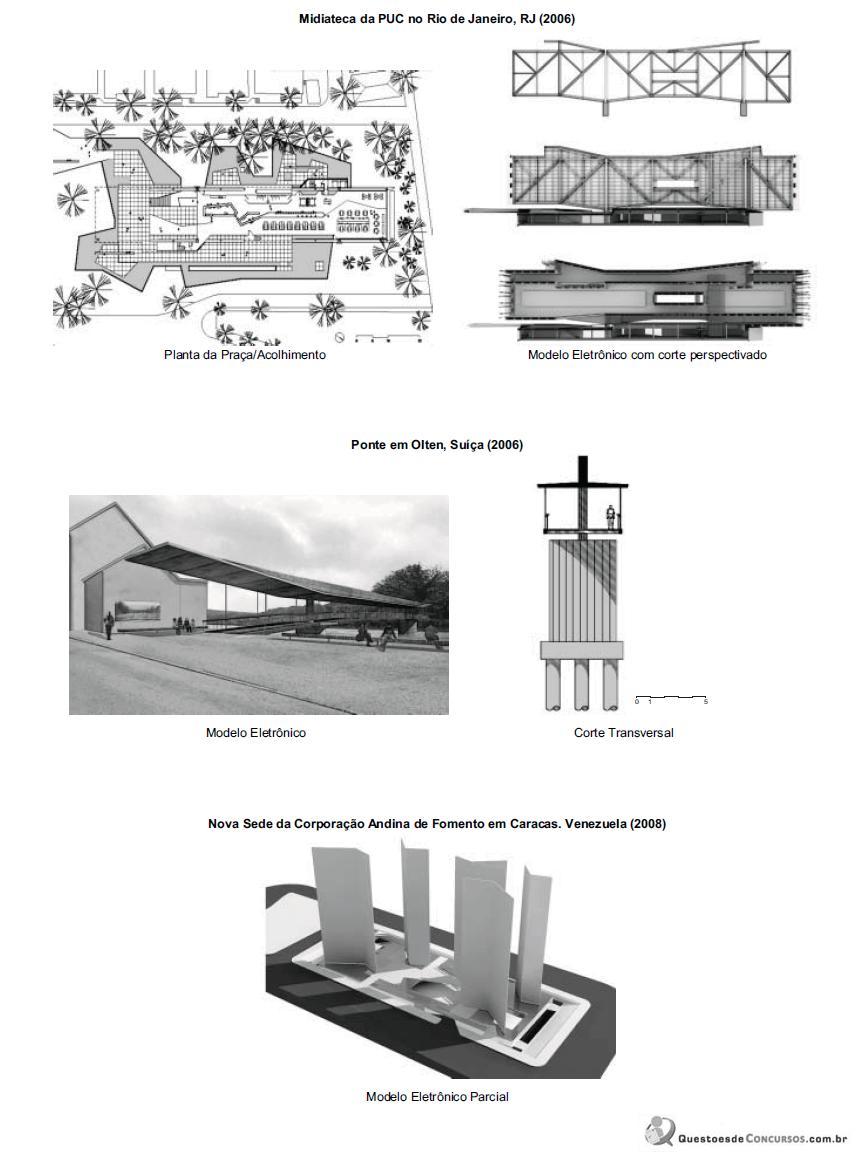
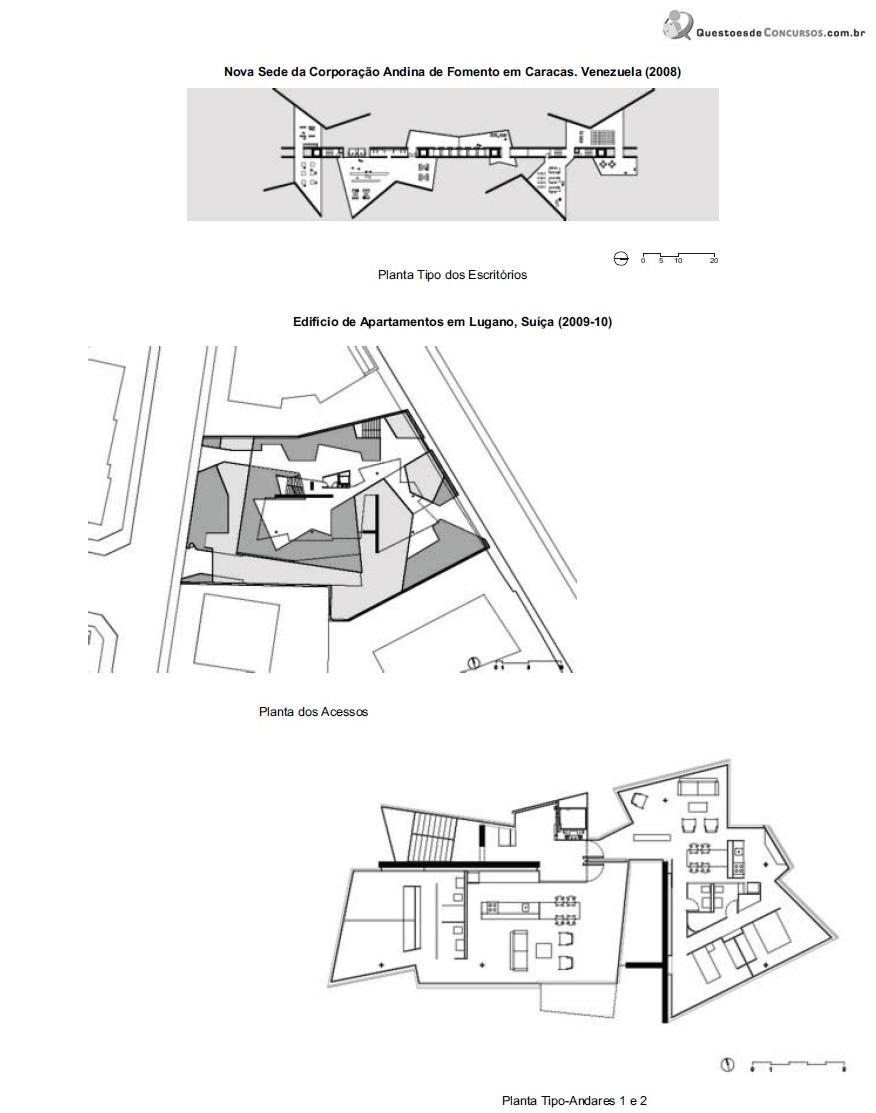
Em relação aos princípios fundamentais dessa arquitetura, constata-se que
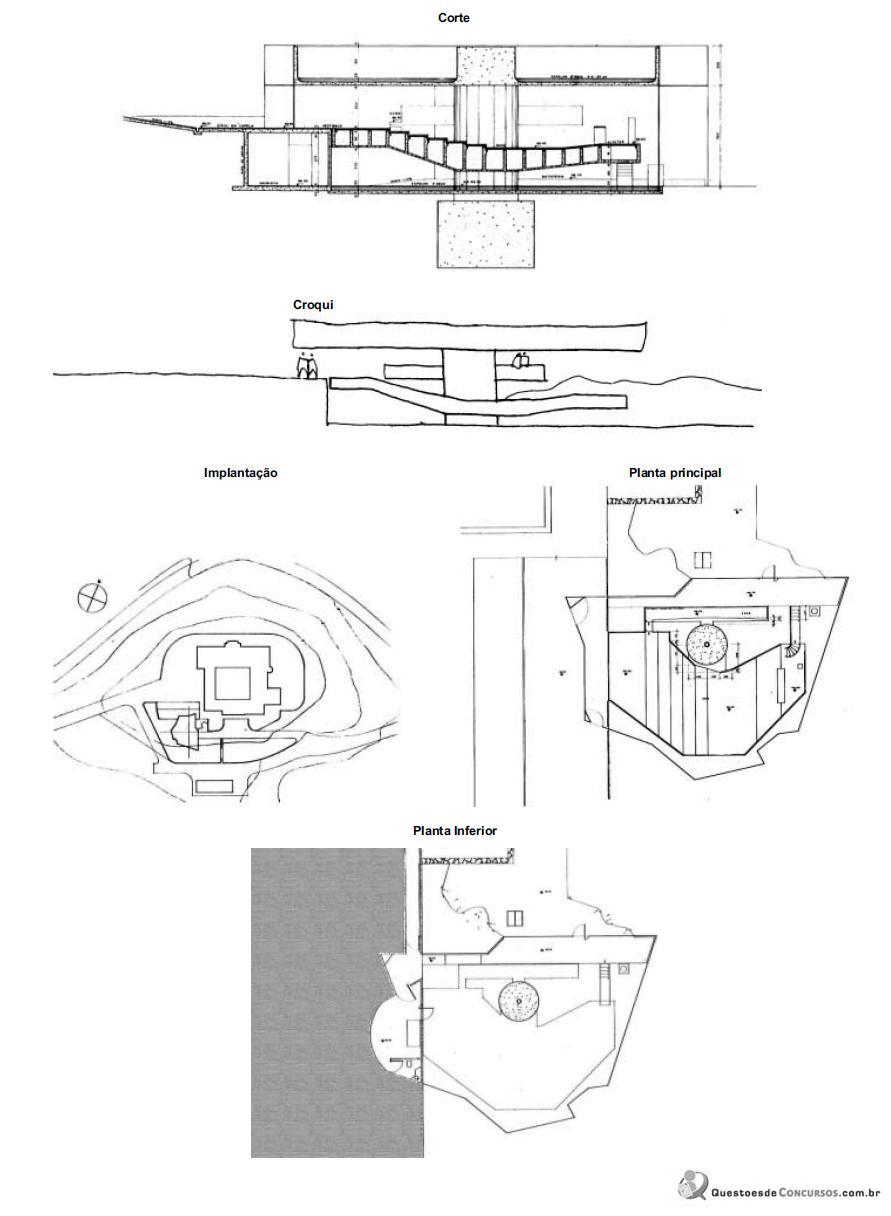
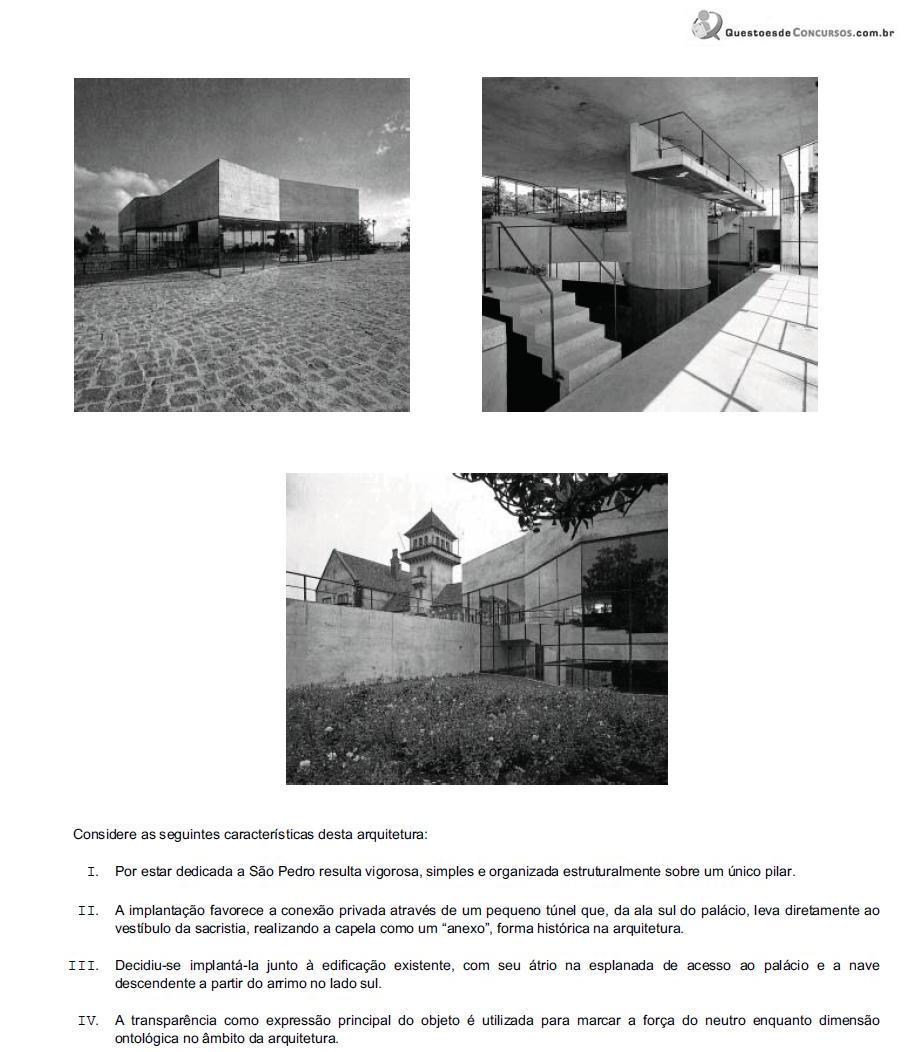
É correto o que consta em
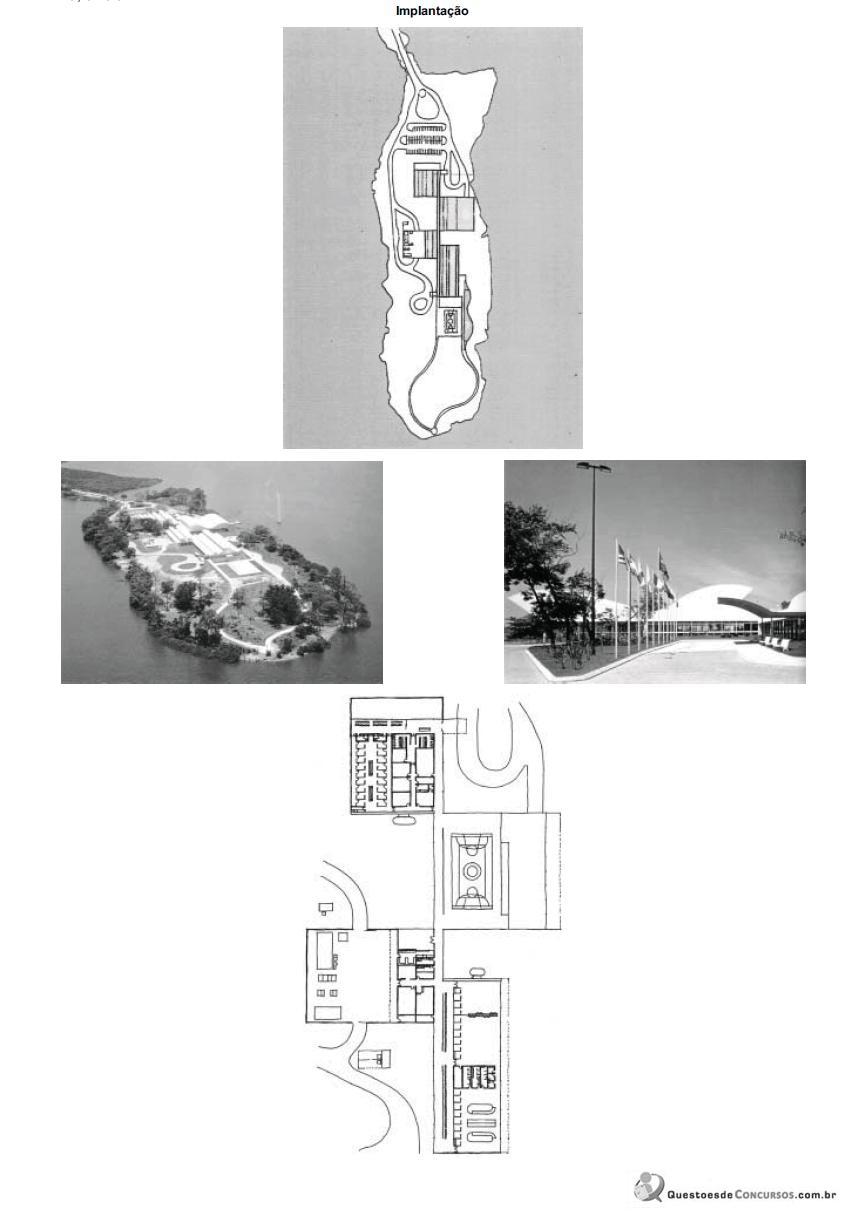
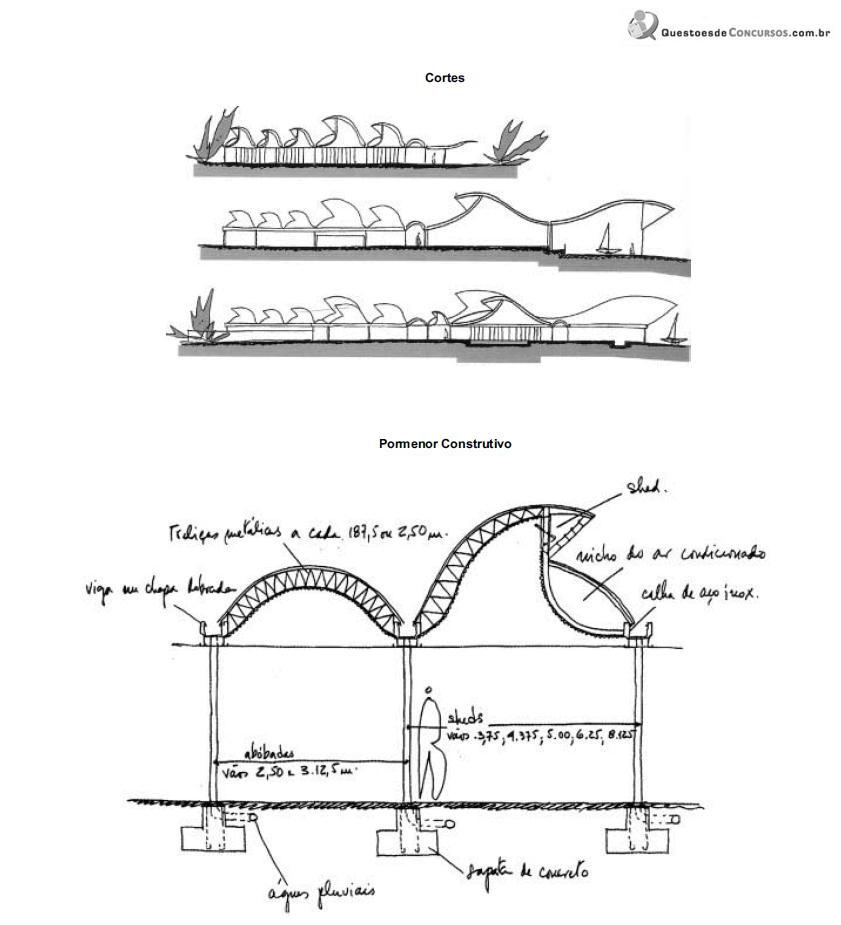
Analisando as imagens, constata-se que
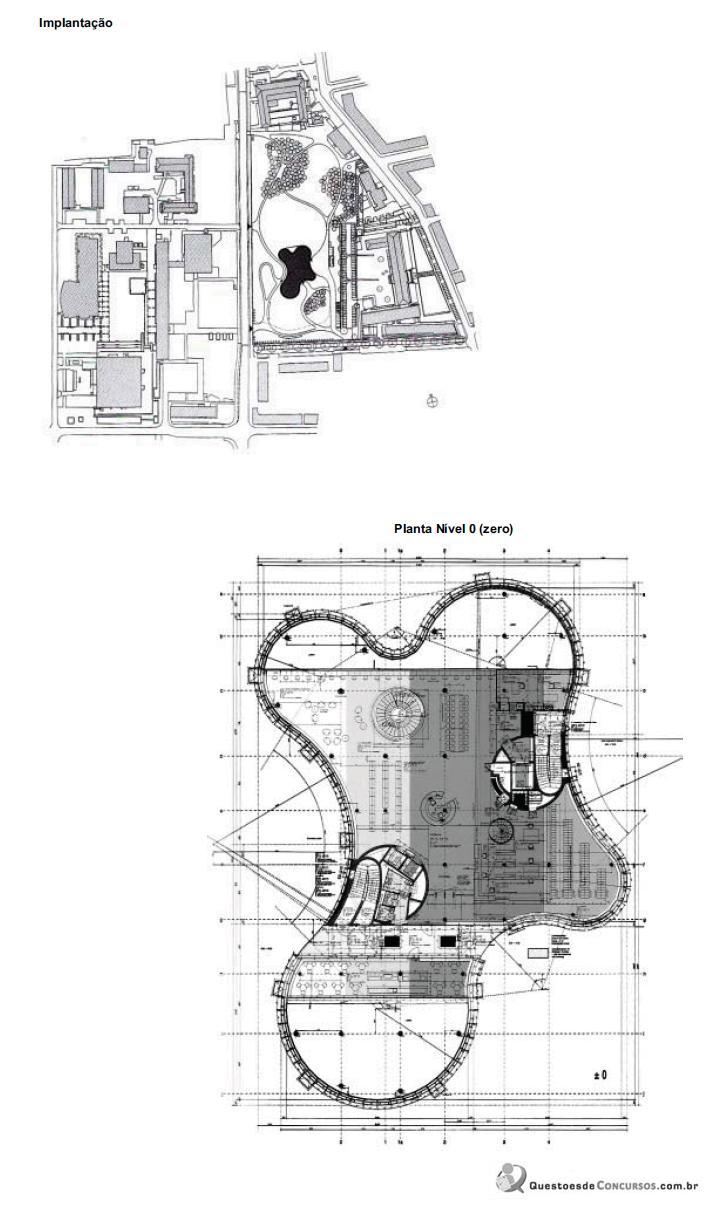
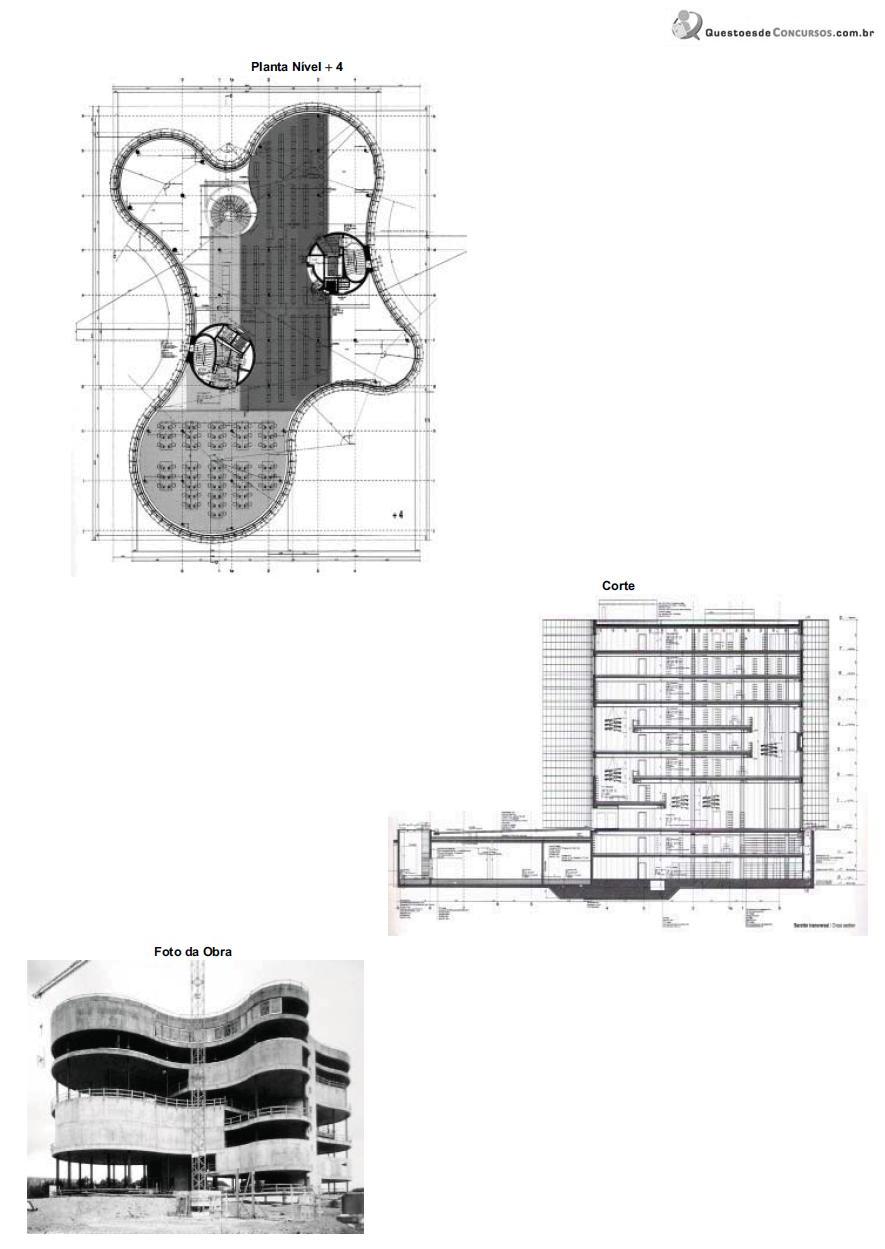
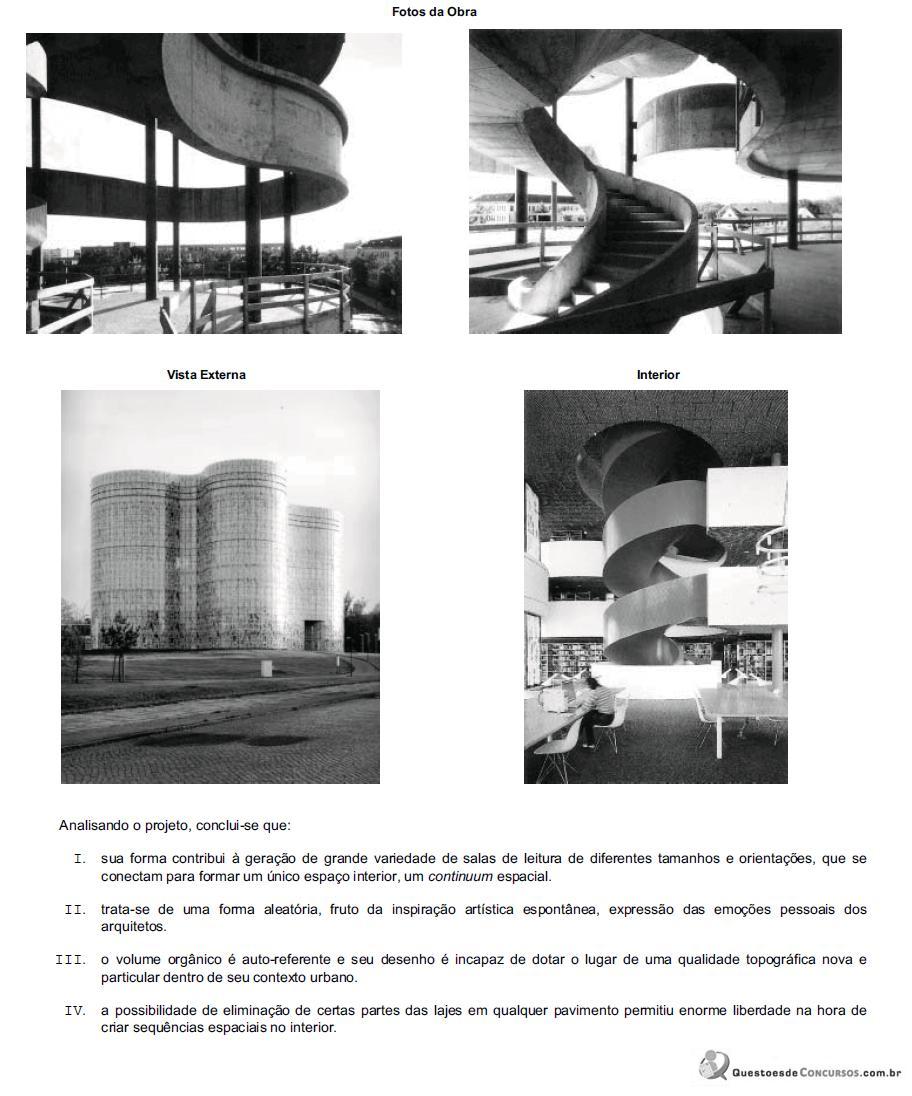
É correto o que consta em
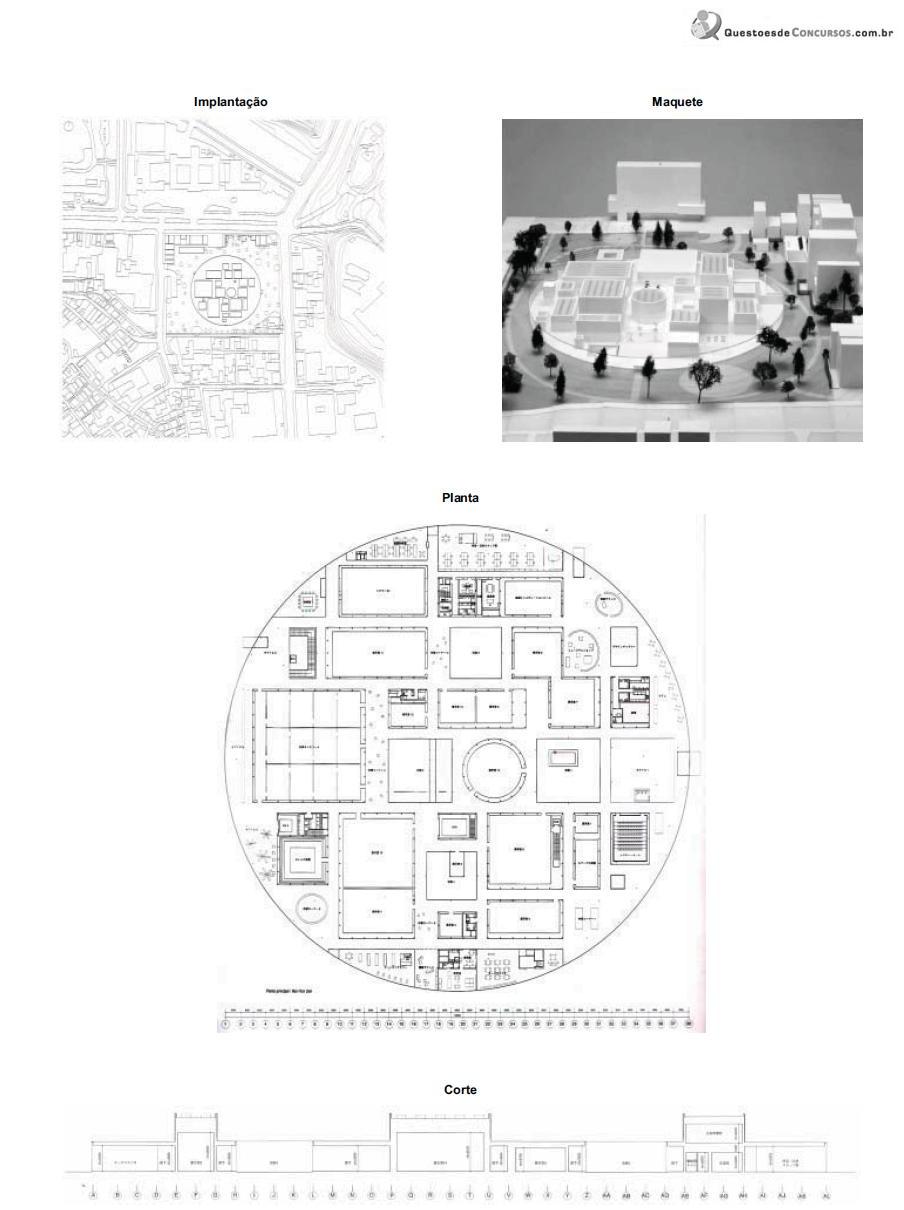
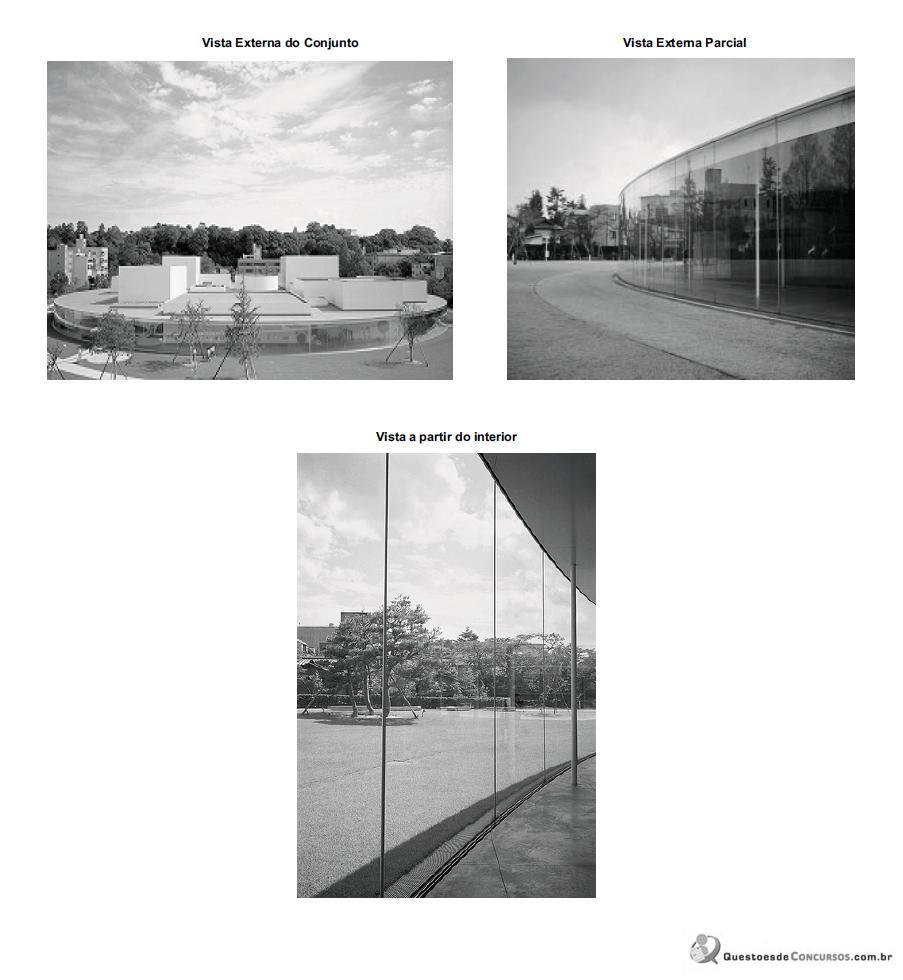
Analisando as imagens, constata-se que
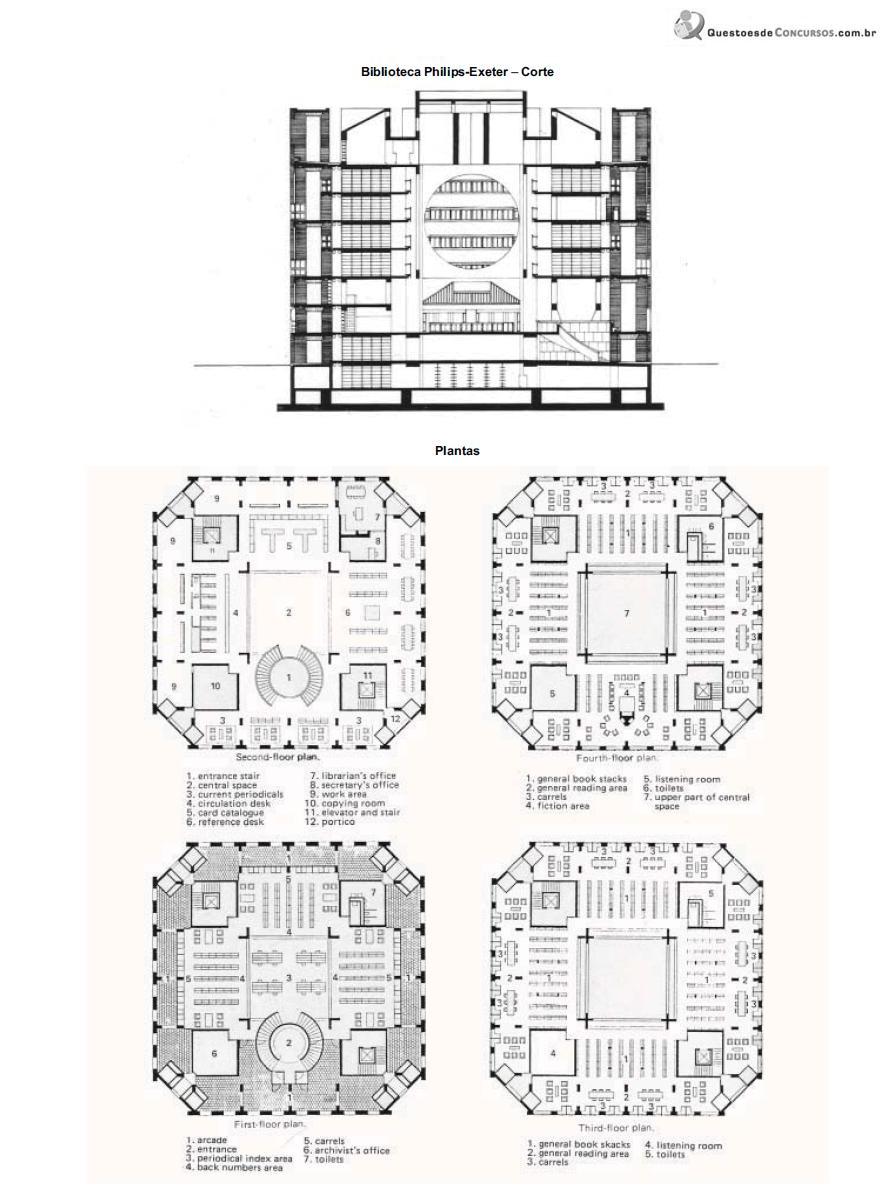
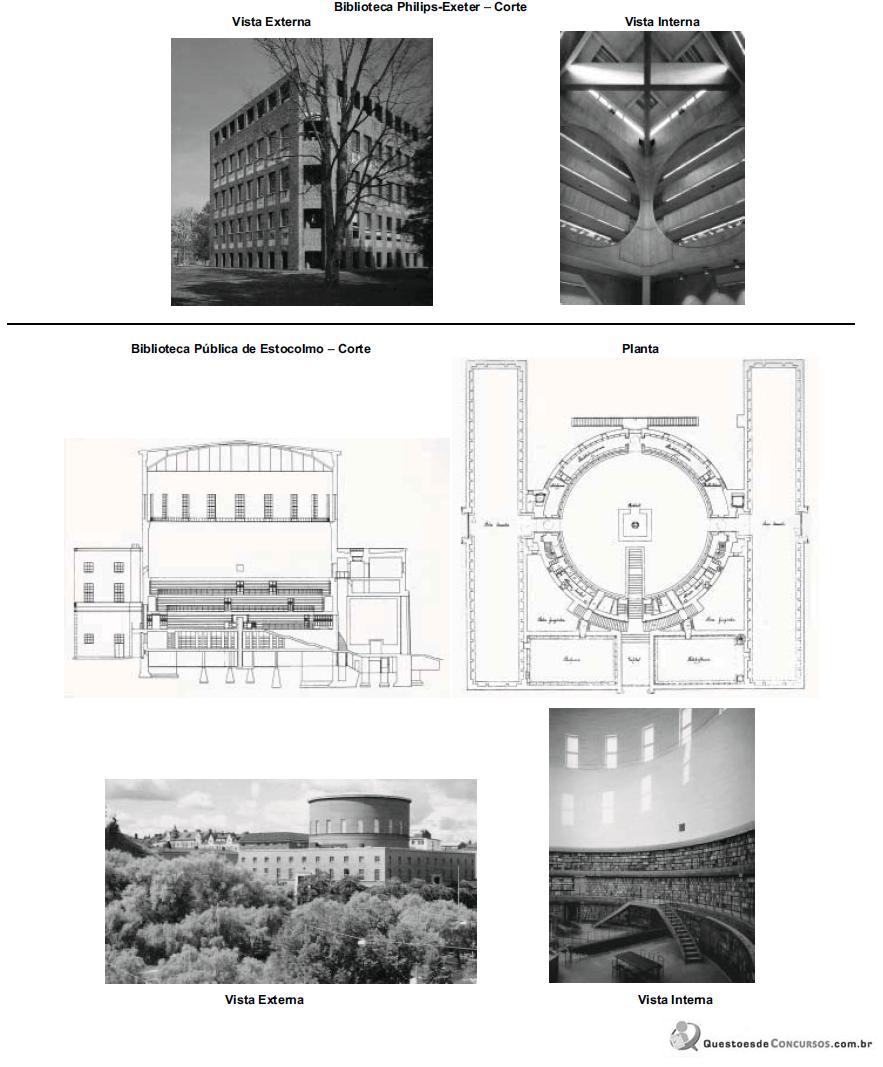
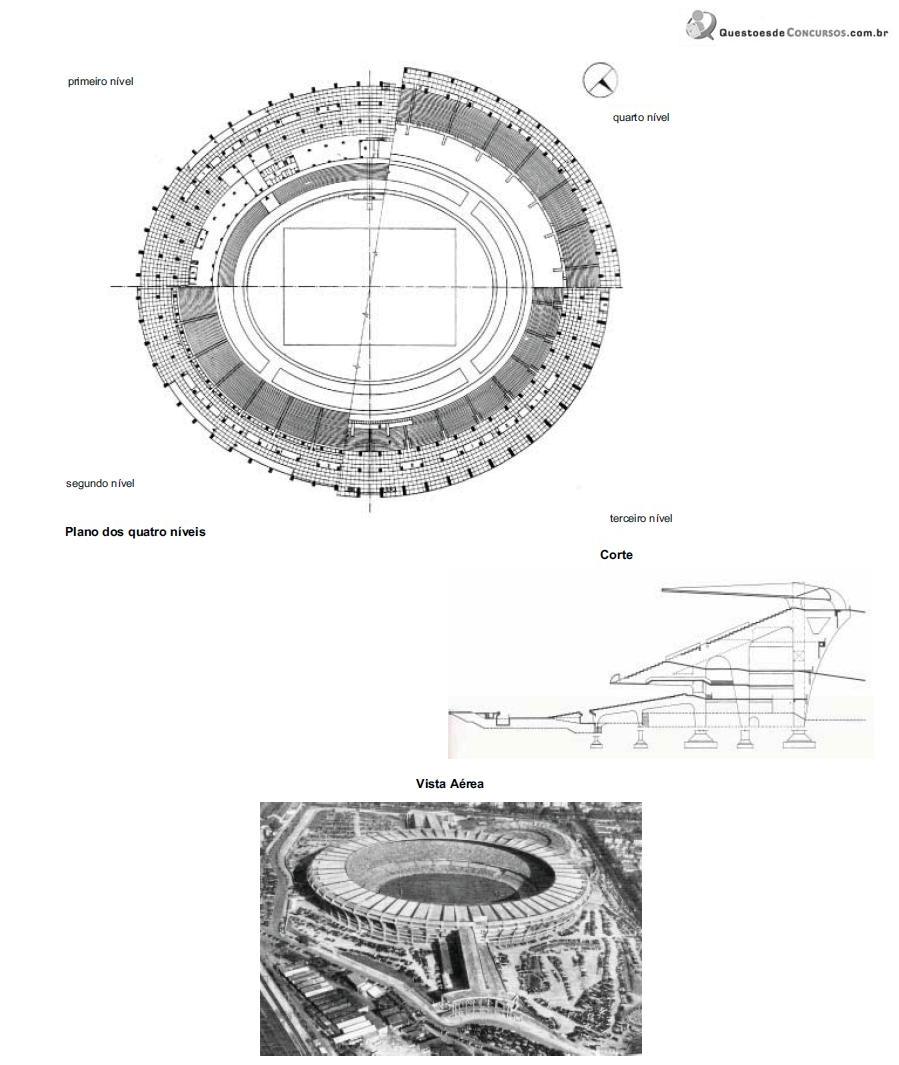
I. "A maior parte dos arquitetos brasileiros parece ser capaz de resolver os diversos problemas de um programa complexo com uma planta simples e concisa e cortes claros e inteligentes."
II. "O Brasil já tinha e mantém a tradição de realçar a superfície de suas fachadas, tão submetidas à pressão do clima tropical, por meio do tratamento estrutural das superfícies planas."
III. "A arquitetura brasileira elaborou uma linguagem auto-suficiente, como se fosse uma manifestação da teoria da linguagem, como algo submetido a leis estruturais imanentes e capazes de explicar sua própria evolução."
IV. "Conceitos como 'lugar', 'tipo', 'monumento' e 'forma urbana' foram tão influentes para a arquitetura contemporânea brasileira que se converteram em termos de referência corriqueiros."
É correto o que consta APENAS em
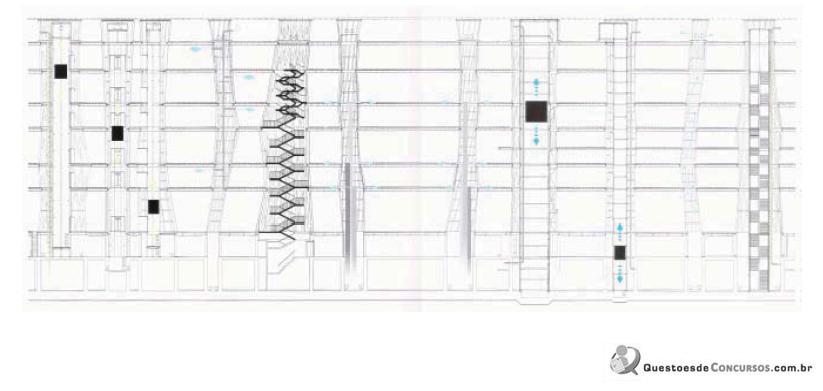
Com relação às informações que os cortes podem fornecer, verifica-se que
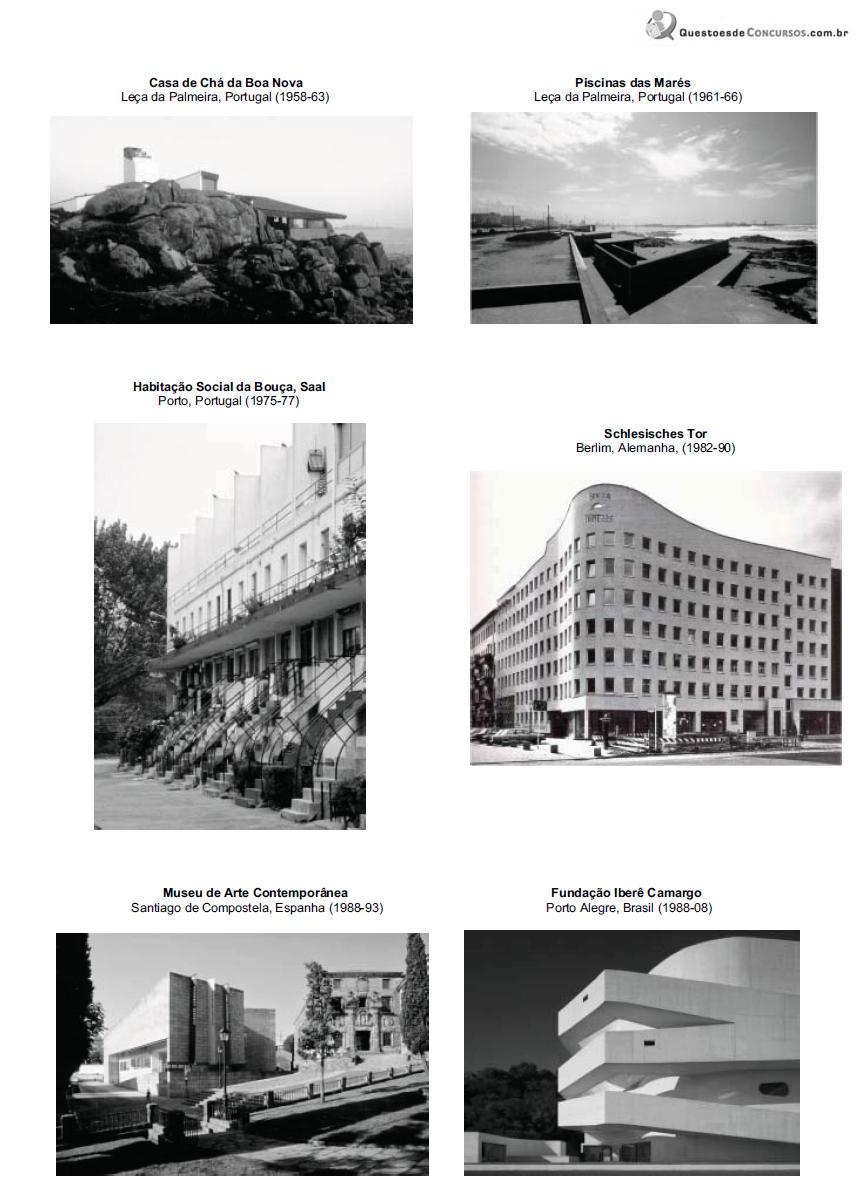
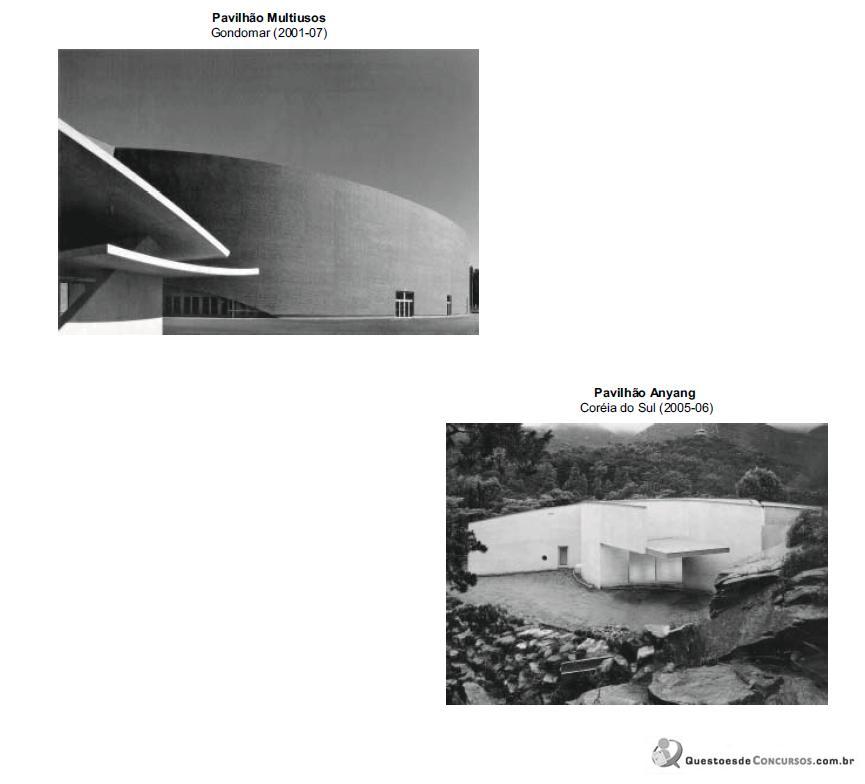
Considerando conceitos fundamentais sobre arquitetura, sociedade e cultura, afirma-se:
I. Num longo percurso que remonta aos anos 50, Siza nunca é imune ao que se passa na cultura arquitetônica.
II. A chave que explica a longevidade de sua arquitetura é o fato de Siza evitar a fixação de respostas, que é o mecanismo das modas.
III. A arquitetura de Siza deixa-se tomar pelo espaço do outro; permite o diálogo entre forças antagônicas; divide-se; regressa; recupera a própria história para depois derivar.
IV. A arquitetura de Siza nunca é tão leve, ou feliz, ou esperançosa, como no Novo Mundo, porque é um processo de dúvidas expostas, transporta uma consciência de falibilidade, decorre de um mundo já experimentado.
É correto o que consta em